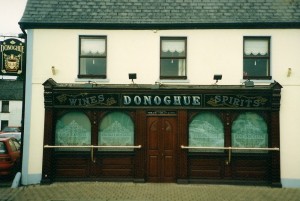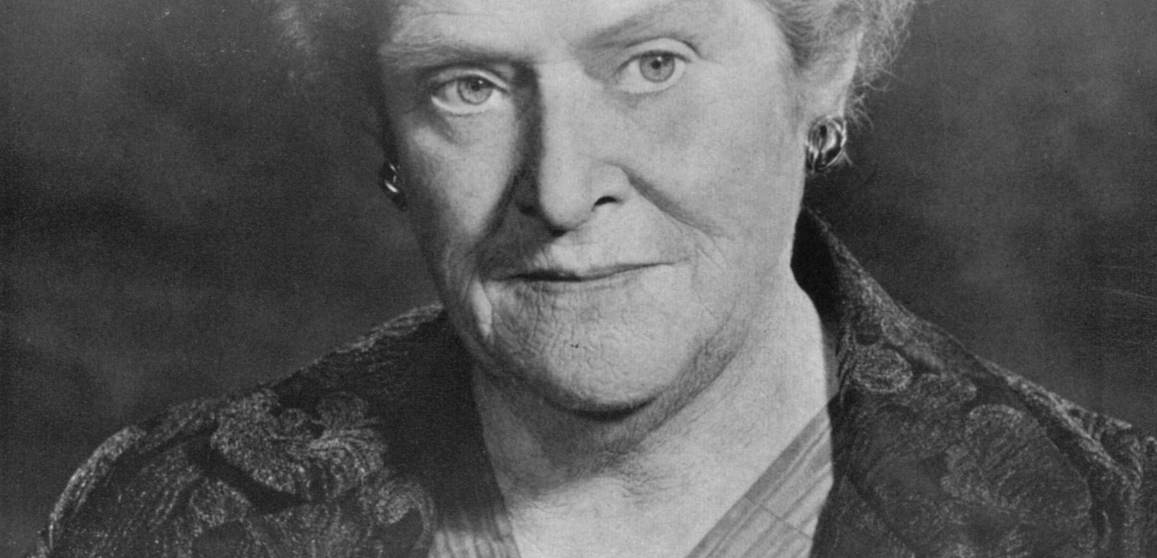
I can claim a certain kinship with Helen Maybury Roe: not only was she a medieval historian, as I am, but she was also from my home county of Laois in the Irish Midlands. Though never formally trained as a historian, Roe was a key figure in developing interest in the study of medieval Ireland during the early years of Irish independence.
Helen Roe was born in December 1895, the only child of a prosperous Church of Ireland family from the small town of Mountrath. Her father, William Ernest Roe, was a mill owner, and his family had been prominent in the town for many generations; her mother, Anne Lambert Shields, came from Birr, Co. Offaly. Roe attended primary school in Mountrath and went on to secondary school in nearby Abbeyleix, though for at least part of her teenage years she lived in the county town of Portlaoise.
At the outbreak of World War I in 1914, Roe joined the St John’s Ambulance Brigade. She served as a volunteer at the Cambridge Military Hospital and as a cook at Aldershot Barracks in England, before returning to Ireland at the war’s end. There, she worked briefly at the Military Hospital in Bray, Co. Wicklow. Her experiences during the Great War also shaped her perceptions of herself as an Irishwoman. Though she had volunteered to help the British war effort, as would have been expected of a member of the Protestant Ascendancy class, in England she was seen only as Irish—in fact, English soldiers spat at her for being Irish during the 1916 Rising—and for the rest of her life Roe was strongly inclined towards nationalism despite her religious background.1 Immediately after the war, Roe travelled in Europe as a private tutor, and her visits to museums in England, Italy, and Greece during this period helped to shape her later assessments of Irish art and archaeology in a broader historical context.2
Helen Roe then entered Trinity College Dublin, where she earned a B.A. in Modern Languages in 1921, and a Master’s degree in the same subject in 1924. According to Nicholas Robinson, “she would have been an unusual undergraduate: a fine woman with red hair, erect, assured and not to be cowed by the atmosphere of TCD. “What professor,” she used to say, “could intimidate someone who had faced a sergeant-major at Aldershot?””3
![The medieval font of St. Lawrence's Church, Rathmore, Co. Meath, one of the artefacts studied by Helen Roe. TRIARC - Edwin Rae Collection. [Image source]](https://yvonneseale.org/wp-content/uploads/2015/12/ertk2350-241x300.jpg)
On graduation, Roe began a teaching career, working briefly at The Royal School in Dungannon, Tyrone, and then in Alexandra College, Dublin. However, the failure of her father’s business—coupled with societal expectations that an only female child would serve as caregiver to her ageing parents—soon brought her back to the Midlands. In 1926 she became the first person to hold the post of County Librarian in Laois.4
Roe’s real interest in historical studies seems to have begun around this time. She collected artefacts which would become the core of the Laois County Museum’s collections. She also travelled around the county—driving her own car, a rarity for a single woman at the time—giving lectures on the antiquities of Laois, accompanied by a magic lantern slide show. Her car did double duty here, as its battery powered the lantern. One such talk was given at my alma mater, the Brigidine Convent Secondary School in Mountrath, where Roe helped to inspire a love of Irish history in one of Ireland’s first female archaeologists, Ellen Prendergast.5
On her retirement from the library service in 1940, Helen Roe moved to Dublin and was able to devote herself wholeheartedly to her studies of medieval Ireland: reading widely on Irish and European history, travelling the country photographing sites and artefacts, and gaining practical experience in archaeology. She was a volunteer on the excavation of the famous Neolithic sites of Fourknocks and Knowth in Meath, and contributed to the publication of the excavation reports on those sites. Her scholarly output was too prolific to discuss it here in detail—in the next 48 years, she published 37 articles in the Journal of the Royal Society of Antiquaries of Ireland alone.6 She also contributed items to journals such as An Leabharlann, Béaloideas, Seanchas Ard Mhacha, and Carloviana, and appeared regularly in the newspapers the Irish Press and the Leinster Express.
Helen Roe’s main area of research was medieval art history and religious history, on a variety of topics, including baptismal fonts, heraldry, and illustrations of the Trinity. However, she published particularly on high crosses. She wrote pamphlets on The high crosses of western Ossory (1958) and High crosses of Kells (1959), but it was her article, “The ‘David Cycle’ in Early Irish Art” (1949) which was especially influential for historians working in this area.7 In the article, Roe argued that many of the figural scenes on Irish high crosses came from a distinct Old Testament sequence, an observation which had not previously been made.
![Helen Maybury Roe's gravestone, Mountrath. [Image source]](https://yvonneseale.org/wp-content/uploads/2015/12/126753167_1396019153-225x300.jpg)
In 1965, Roe was the first woman to be elected president of the Royal Society of Antiquaries of Ireland, a position which she held until 1968. Her presidential address, delivered in January 1966, focused on Gothic art and architecture in later medieval Ireland.8 By all accounts, she was an enthralling speaker with a gift for vivid description—a knight in armour was “encased in a glorified sardine can”; a tomb effigy in Kildare Cathedral was referred to as “good old Bishop Wellesley” and greeted with a hearty slap on the thigh—and Roe continued to lecture to audiences across the country into her nineties.9 She was elected a member of the Royal Irish Academy in 1984, a belated but fitting cap to her academic career.
Helen Roe died in May 1988 and was buried in the family plot in the churchyard of St Peter’s Church of Ireland, Mountrath. Her gravestone (pictured right) was a fitting one for a historian of early medieval Ireland and its funerary monuments: a simple recumbent slab with a Celtic cross etched into the head and the Irish-language phrase solas Dé da h-anam (“the light of God to her soul”) carved at the foot.
On her gravestone, Helen Maybury Roe is identified, solely and proudly, as “Antiquary.”
References:
1 Rory O’Farrell and Christine Bromwich, “Helen M. Roe (1895-1988)” in Jane Chance (ed.), Women Medievalists and the Academy (Madison, WI: University of Wisconsin Press, 2005), 461.
2 Andrew O’Brien, “Roe, Helen Maybury,” in James McGuire and James Quinn (eds.), Dictionary of Irish Biography (Cambridge: Cambridge University Press, 2009). [Link]
3“Official Opening of the Helen Roe Theatre 21st January, 1993”, The Journal of the Royal Society of Antiquaries of Ireland 122 (1992), 155
4 A collection of Helen Maybury Roe’s papers from this period are held in the Laois County Archives. [Link]
5 “Obituary: Ellen M. Prendergast”, The Irish Times, May 24, 1999. [Link]
6 A partial bibliography of Helen Roe’s writings can be found at RI-Opac. [Link]
7 Helen M. Roe, “The “David Cycle” in Early Irish Art”, The Journal of the Royal Society of Antiquaries of Ireland 79:1/2 (1949), 39-59.
8 Helen M. Roe, “Some Aspects of Medieval Culture in Ireland”, The Journal of the Royal Society of Antiquaries of Ireland 96:2 (1966), 105-09.
9 H.A.K., “Helen Maybury Roe”, Archaeology Ireland 2:3 (1988), 86; O’Farrell and Bromwich, “Roe”, 465.

I was a great admirer of Miss Roe and she was very supportive to young women in the profession. She retired from the library service at age 45, because she told some of us once, two aunts died about the same and each left her a legacy – if only one had died, she said, she could not have afforded to retire, but two legacies allowed her to do so, and move to Dublin to be near the big libraries.
Thank you for commenting! That piece of information answers one of the things I was curious about, because she did seem to retire at a very young age, particularly as I’m sure the state pension wasn’t very large in the Ireland of the 1940s. Much hasn’t changed, it seemed—”five hundred a year and a room of one’s own” are still so necessary to support women’s scholarship.
Pingback: Local history and the Millses in Ireland – Milling 'round Ireland: A Mills family story